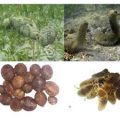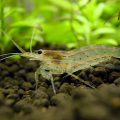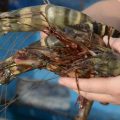annual production of about 50,000 mt. However, outbreak of viral diseases such as White Spot Syndrome Virus (WSSV), Hypodermic Haematopoetic Infectious Necrosis Virus (IHHNV), Taura Syndrome Virus (TSV), and Yellow Head Virus (YHV) have caused the slump of the industry.

The Industry Strategic S&T Program (ISP) on Shrimp aims to revitalize the shrimp industry by reducing the occurrence of diseases in shrimps and to improve yields through sound management practices.
Recognizing shrimp as an important aquaculture commodity, the Philippine Council for Agriculture, Aquatic and Natural Resources Research and Development of the Department of Science and Technology (DOST-PCAARRD), funded the Shrimp S&T Program under the leadership of Dr. Valeriano L. Corre, Jr. of the University of the Philippines in the Visayas, Miagao, IIoilo, starting in 2011.
The program has developed technologies to boost the development of the shrimp industry.
Biofloc technology and use of immunostimulants have been pilot tested in seven farms in the Philippines (3 in Luzon, 2 in the Visayas, and 2 in Mindanao). An average of 5.5 kg/cu m in tanks were realized. In ponds, an average of 18 tons/ha for P. vannamei was produced in the first run of the trials. An FCR of 1.3 was attained with 95% survival rate with a stocking density of 800,000 per hectare in a 90-day culture period.
A modified automatic feeder has been designed to minimize feed wastage and production cost in intensive shrimp ponds. The local model costs PhP15,000 compared to the commercially available Thai model, which costs US $550 in Manila.
A LAMP-based diagnostic kit was developed as a practical alternative to the conventional polymerase chain reaction (PCR) and standard microbiological techniques in the detection of WSSV. The kit is now being pilot tested in different State Universities and Colleges and in private sector farms in Bohol, Bataan, Davao, Iloilo, and Cebu. The LAMP-based detection is aided by a heat block apparatus which replaces the expensive thermal cycler.
A prototype genome (DNA)-based lateral flow strip biosensor (LFSB), which can detect WSSV has also been developed. The device includes test strips, an extraction and mobile strip reader with an accompanying application that instantaneously allows results to be uploaded to an on-line information and bio-surveillance data center.
Whole genome sequences of 273 pathogen samples have been produced, of which 200 have already been assembled and identified up to species level through bioinformatic analysis. Currently, the team is processing these sequences for the identification of new Vibrio biomarkers for infection diagnosis.
A study to produce high health P. monodon broodstock and fry is ongoing. To date, F3 captive shrimps have been produced. Studies are still underway to determine the causes of non-maturity of the spawns.
It is hoped that the technologies developed from the program will boost the shrimp industry.
DOST-PCAARRD will showcase these technologies under its Shrimp S&T Program, including other agri-aqua science and technology (S&T) outputs on March 2-4, 2016 during the Council’s SIPAG FIESTA at its headquarters in Los Baños, Laguna.
SIPAG, a technology transfer strategy, embodies the Council’s commitment to DOST’s Outcome One in a bid to ensure that the fruits of R&D activities for the agri-aqua sectors will be a blessing for every Juan.
by Inland Aquatic Resources Research Division, DOST-PCAARRD






